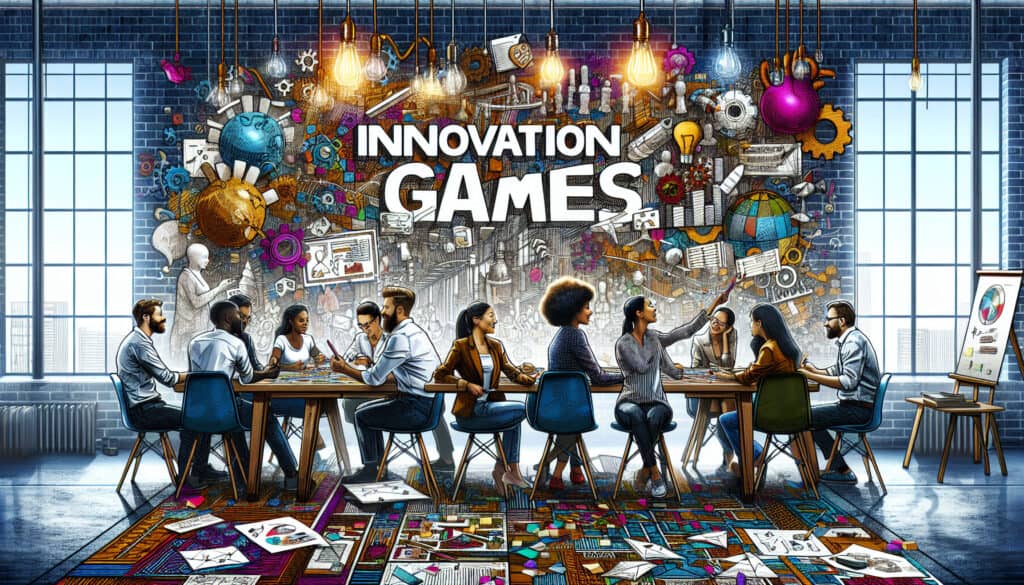A set of collaborative exercises for understanding customer needs and designing new products.
- Methodologies: Customers & Marketing, Ideation, Product Design
Innovation Games

Innovation Games
- Agile Methodology, Customer Experience, Customer Journey Mapping, Design Thinking, Innovation, Market Research, Prototyping, User experience (UX), User-Centered Design
Objective:
How it’s used:
- A collection of qualitative research methods that use games to help customers articulate their needs and desires. These games are designed to be more engaging and insightful than traditional market research techniques.
Pros
- Provides deep insights into customer needs; Can be more engaging and fun than traditional research methods.
Cons
- Can be time-consuming and expensive to conduct; Requires a skilled facilitator.
Categories:
- Customers & Marketing, Product Design
Best for:
- Understanding customer needs and designing new products and services in a collaborative and engaging way.
Innovation Games can be particularly beneficial in sectors such as technology, consumer goods, healthcare, and automotive industries, where understanding user requirements is pivotal for product development. These engaging methodologies can be utilized in various project phases, notably during ideation and concept validation, often following traditional research approaches to enrich the data collected. Sessions typically involve cross-functional teams, including product designers, engineers, marketers, and actual customers, who collaborate to shape product concepts based on real-world feedback. Specific game formats, such as “Product Box” or “Empathy Mapping,” encourage participants to express their thoughts creatively, allowing for a deeper exploration of desires and pain points beyond surface-level responses. These sessions can be facilitated in workshops, design sprints, or focus groups, making them adaptable to different organizational cultures. Furthermore, the playful nature of these games can reduce the pressure participants often feel during conventional interviews, leading to more authentic and candid responses. The combination of fun and structured activities generates a rich tapestry of qualitative data, ultimately contributing to more innovative and customer-centric product solutions.
Key steps of this methodology
- Choose a specific game type appropriate for the research goal.
- Facilitate the game, ensuring participants understand the rules and objectives.
- Encourage open dialogue among participants during gameplay.
- Observe interactions and note emerging themes and ideas.
- Capture visual and verbal outputs generated during the game.
- Debrief with participants to explore deeper meanings behind their contributions.
- Identify patterns and clusters from the collected outputs.
- Translate findings into actionable product or service concepts.
Pro Tips
- Incorporate role-playing elements into games to create realistic scenarios that reveal deeper motivations and pain points around product usage.
- Utilize mixed methods within Innovation Games, combining qualitative data from game results with quantitative data from traditional research for well-rounded analysis.
- Encourage collaborative brainstorming sessions post-game to synthesize findings and directly engage participants in prioritizing their needs and desires.
To read and compare several methodologies, we recommend the
> Extensive Methodologies Repository <
together with the 400+ other methodologies.
Your comments on this methodology or additional info are welcome on the comment section below ↓ , so as any engineering-related ideas or links.
Historical Context
1949
1950
1950
1960
1960
1960
1960
1940
1950
1950
1958
1960
1960
1960
1960
(if date is unknown or not relevant, e.g. "fluid mechanics", a rounded estimation of its notable emergence is provided)















Related Posts
Musculoskeletal Discomfort Questionnaires
Multivariate Testing (MVT)
Multiple Regression Analysis
Motion Capture Systems
MoSCoW Method
Mood’s Median Test